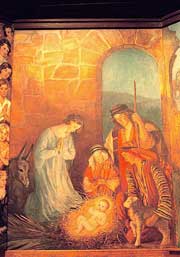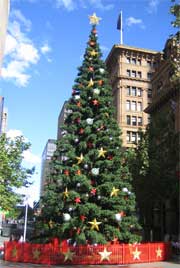Top searches
Christmas season celebrations in Australia

Adoration of Shepherds, Violet Teague (1872-1951). Oil on canvas, 1931. Photograph by Colin Holden.
Image courtesy of Anglican Church of Australia Archive
Christmas is celebrated in many parts of the world on 25 December. Protestant and Roman Catholic churches hold Christmas Day services on 25 December. The Eastern churches - the Ethiopian Orthodox church, Russian Orthodox church and the Armenian church - celebrate Christmas on 6 or 7 January. There have been rituals, parties and celebrations at this time of year for thousands of years.
The birth of Jesus
Christmas is the celebration of the birth of Jesus Christ. Christians believe that Jesus is 'the son of God', the Messiah sent from Heaven to save the world.
The 'Christmas story' tells of the birth of Jesus in a stable in Bethlehem, the angels announcing the birth to the shepherds in the fields, and the Magi (wise men from the East) visiting the stable and offering gifts to the newborn child.
The origins of Christmas
A Roman almanac confirms that 25 December was used to celebrate Christmas in 336 AD, although it was nearly 600 years later that the churches created a liturgy - a service for public worship - for the occasion.
The choice of date is believed to have been influenced by the northern hemisphere winter solstice, as well as ancient pagan rituals that coincided with the solstice. These rituals included the Halcyon Days in Greece, a period of calm and goodwill when it was believed the sea was calm for birds to lay their eggs; and the Roman celebration of Saturnalia, a celebration of the god Saturn, which involved wild parties, the exchange of gifts and the temporary suspension of social divisions between slaves and masters.
Christmas traditions and symbols
Christmas trees are part of a long tradition of greenery being taken into the home at Christmas to brighten the dreary winter. Mistletoe was popular with Druid priests because it remained green throughout winter. Holly placed over the doorway was believed to drive away evil. Placing branches from trees in the home was first recorded in 1494, and by the beginning of the 1600s there are records of fir trees being decorated with apples.
The story of Santa Claus has its origins in the legends surrounding the humble generosity of Saint Nicholas, whose feast day is celebrated on 6th December. Saint Nicholas was a 4th century Christian Bishop from Myra (in modern-day Turkey) who became the Patron Saint of Children. In Germany and Poland, boys dressed up as bishops begging alms for the poor. Later, the Christ child 'Christkindlein' was said to have accompanied Nicholas-like figures on their travels. The 1822 poem Twas the Night before Christmas forged the link and Saint Nicholas (Father Christmas, Pere Noel, Christ Kind, Kriss Kringle or Sinter Klass) became known as Santa Claus.
Christmas in the southern hemisphere
The heat of early summer in Australia has an impact on the way that Australians celebrate Christmas and on which northern hemisphere Christmas traditions are followed.
In the weeks leading up to Christmas houses are decorated; greetings cards sent out; carols sung; Christmas trees installed in homes, schools and public places; and children delight in anticipating a visit from Santa Claus. On Christmas Day family and friends gather to exchange gifts and enjoy special Christmas food.
Many Australians spend Christmas out of doors, going to the beach for the day, or heading to camping grounds for a longer break over the Christmas holiday period. It has become traditional for international visitors who are in Sydney at Christmas time to go to Bondi Beach where up to 40,000 people visit on Christmas Day.
Carols and music

A photo of Santa arriving at the beach by boat. Image courtesy of the National Archives of Australia : A1500, K26950
The tradition of an Australian Christmas Eve carol service lit by candles was started in 1937 by radio announcer Norman Banks. This outdoor service has now been held in Melbourne every year since then.
Carols by Candlelight events today range from huge gatherings, which are televised live throughout the country, to smaller local community and church events. Sydney's Carols in the Domain has become a popular platform for the stars of stage and music.
Some uniquely Australian Christmas carols have become popular and are included alongside the more traditional carols sung at carol services and at Christmas church services: John Wheeler's The Three Drovers is perhaps the best known of these.
Many light hearted Australian Christmas songs have become an essential part of the Australian Christmas experience. These include Rolf Harris's Six White Boomers, Colin Buchanan's Aussie Jingle Bells and the Australian Twelve Days of Christmas.
Christmas plants
There are many native Australian plants in flower over the Christmas season. A number of these have become known as 'Christmas plants' in various parts of the country, including christmas bells, christmas bush and the christmas orchid.
When Europeans first arrived in Australia they were delighted that they could pick wildflowers resembling bells and bright green foliage covered in red or white flowers to use as Christmas decorations. This was a huge contrast to the bare trees and dormant gardens they had left behind in Europe.
Food
Christmas in Australia comes at the beginning of summer and many people no longer serve a traditional hot roast dinner. Cold turkey and ham, seafood and salads are often served instead. It has even become acceptable to serve the traditional christmas plum pudding with cold custard, ice cream or cream. Pavlova, a meringue base topped with whipped cream and fresh fruit, and various versions of the festive ice cream pudding have also become popular Christmas desserts.
The Commonwealth Scientific and Industrial Research Organisation (CSIRO) and the Coles company are engaged in a project to cultivate native foods. They are working with Mandawuy Yunupingu (of the band Yothu Yindi) and Aboriginal communities to grow sufficient quantities for sale in supermarkets across Australia. The aim is to offer all Australians a Bush Tucker Christmas.
Film and television

Christmas tree in Martin Place, Sydney 2005. File photograph.
Copyright Commonweatlh of Australia
The films Bush Christmas (1947) starring Chips Rafferty and the remake Prince and the Great Race in 1983 (with Nicole Kidman), and Miracle Down Under starring John Waters (telecast as Bushfire Moon) are insights into the early Australian Christmas culture. Many television series have used Christmas episodes to explore the changing culture of Christmas in Australia.
Children's stories
Australian children grow up enjoying traditional Christmas stories such as Clement Clarke Moore's 'Twas the Night Before Christmas and Charles Dickens' A Christmas Carol, but children's authors and illustrators are beginning to create truly Australian children's Christmas literature. One favourite is Wombat Divine by Mem Fox, while a more recent addition is Aussie Night Before Christmas by Yvonne Morrison.
Major sporting events
The Christmas break is an opportunity for sports fans to enjoy two major sporting events. 26 December is the opening day of the 'Boxing Day Test' between the Australian Cricket Team and an international touring side at the Melbourne Cricket Ground. This has been well attended since the first match in 1950, and watched by many others on television. In Sydney one of the world's most prestigious ocean races, the Sydney-to-Hobart Yacht Race, starts on Boxing Day from Sydney Harbour.
Indigenous Australians
Indigenous Dreamtime stories obviously do not include Christmas. However, this date in the calendar coincides with other seasonal changes. In Arnhem Land, Northern Territory, Yolngu Aboriginal people will observe the last season of their six-season cycle. Gudjewg, the wet season, begins in late December.
Many Aboriginal and Torres Strait Islander communities include Christian groups within them which celebrate Christmas. The Ntaria Choir at Hermannsburg, via Alice Springs, Northern Territory, has a unique musical language from mixing the traditional vocals of the Ntaria women with Lutheran chorales - the hymn tunes that were the basis of much of J.S. Bach's music.
Baba Waiyar, a popular traditional Torres Strait Islander hymn, is featured on Lexine Solomon's debut album This is Woman (2003) - showing the influence of gospel music mixed with traditionally strong Torres Strait Islander vocals and country music. Significantly, Torres Strait Islanders celebrate the 'Coming of the Light' on 1 July, the day the London Missionary Society landed at Erub Island in 1871.
Modern Indigenous Christmas celebrations are beginning to take on elements of traditional Indigenous culture. The Department of Conservation and Land Management in Western Australia offers a Christmas celebration by organising activities which encourages people to join in Christmas bush activities with Nyoongar guides.
Other celebrations
Although Christmas is a widely recognised holiday worldwide, there are other major festivals which occur around the same time: the Jewish people commemorate Hanukkah, Muslims observe Ramadan, African Americans celebrate Kwanzaa, and the festival of Ta Chiu is held in Hong Kong.
Hanukkah

In the Jewish religious calendar, the festival Hanukkah (the Hebrew word for 'dedication') commences on the 25th of Kislev, and continues for eight days. It is also referred to as the 'Festival of Lights' and celebrates a victory by a small Jewish army over the Greeks in the second century BC.
During Hanukkah, children play with a dreidel or sevivon ('spinning top'), and also receive gifts of 'Hanukkah money'. Special feasts for the children and competitions for youths are arranged. In countries where Christmas is celebrated, Hanukkah, particularly among Reform Jews, has assumed a similar form.
Kwanzaa

In North America, Kwanzaa is a holiday celebrated by many African-Americans. It is held from 26 December until 1 January. It was started in 1966 by Dr Maulana Karenga, an American academic. The seven-day celebration encourages African-Americans to think about their African roots as well as their life in present day America. Kwanzaa - which means 'first fruits' - is based on African festivals.
Ramadan

The Islamic month of Ramadan sees Australia's significant population of Muslims observe traditional Ramadan practices including fasting daily from dawn to sunset. Ramadan is important for Muslims because it is believed to be the month in which the first verses of the Koran (the divine scripture) were revealed by Allah (God) to the prophet Muhammad. The Islamic calendar is only 354 days long,so Ramadan moves forward in relation to the Gregorian (Western) calendar.
Ta Chiu

Ta Chiu is a Taoist festival of peace and renewal that takes place on 27 December in Hong Kong. The participants summon all of their gods and ghosts so that the gods' collective power will renew their lives. At the end of the festival, priests read aloud the names of every person who lives in the area. Then they attach the list of names to a paper horse and set it aflame, letting the names rise to heaven.
Related Culture and Recreation Portal stories
Useful links:
The birth of Jesus
The origins of Christmas
Christmas traditions and symbols
Christmas in the southern hemisphere
Carols and music
- Carols by Candlelight - Melbourne
- Carols in the Domain - Sydney
- Australian Christmas carols
- The Three Drovers
- Six White Boomers
- Aussie Jingle Bells
- Australian Twelve Days of Christmas
- Handel's Messiah
Christmas plants
Food
- Christmas Turkey on the BBQ
- Christmas Plum Pudding
- Pavlova
- Festive Ice Cream Pudding
- Bush Tucker Christmas
Film and television
Children's stories
Major sporting events
Indigenous Australians
- Dreamtime
- Six Season Cycle
- Ntaria Aboriginal Ladies Choir
- This is Woman, Lexine Solomon
- Coming of the Light
Other celebrations
Christmas Greetings
Search over 3,500 Australian websites for information about:
Last updated: 18th January 2007

